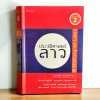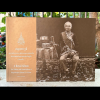
Bon: Tibet's Ancient Religion
Tibet, the highland beyond the Himalayas, seems permeated with an atmosphere of living spirituality. Here in ancient times the religion of Bön was widespread, marked by shamanistic practices and a pronounced cult of the dead. Until well into the eighth century, Bön was the dominant religion and culture on the roof of the world; it is in essence the belief system of ancient Tibet. From the second half of the eighth century onward, Bön was superseded by Buddhism, which had traveled north from India, and the two religions came to influence each other in both doctrine and ritual. In spite of the eventual dominance of Buddhism through its position as the state religion, however, a reformed Bön school has been able to assert itself down to the present.
Its tradition continues to remain alive in a few monasteries as well as in visible signs of Tibetan popular religion, including prayer flags and spirit traps, temple and mountain circumambulations, death and marriage rites, oracle techniques, and countless religious rituals. In fact, it may be reasonably asserted that Tibetan culture cannot be completely understood without a knowledge of Bön practices. This book takes the reader to secluded monasteries and sacred sites of the Bön religious community. With its thoroughly informed text and more than 200 photographs of Bön monasteries, lamas, and sacred sites, most undocumented until now, this volume introduces the myths and culture of ancient Tibet.
The preface, written by the spiritual head of all Bönpo, confers additional authority on the work, while its notes, maps, index, and an extensive bibliography make it essential reading for anyone with an interest in Tibet or eastern religions
Publisher : Weatherhill First edition (August 12, 2002)
Language : English Hardcover : 200 pages
ISBN-10 : 0834805170
ISBN-13 : 978-0834805170
Item Weight : 3.49 pounds Dimensions : 9.3 x 0.9 x 12.3 inches
สินค้าที่เกี่ยวข้อง

หนังสือ พุทธภูมิ สุวรรณภูมิ เส้นทางจารึกบุญจารึกธรรมตามรอยบาทองค์พระศาสดา

ประวัติศาสตร์ ลาว พิมพ์เก่าครั้งที่ 2
![สยามประเทศไทยกับดินแดนในกัมพูชาและลาว - ธำรงศักดิ์ เพชรเลิศอนันต์ [ปกอ่อน] สยามประเทศไทยกับดินแดนในกัมพูชาและลาว - ธำรงศักดิ์ เพชรเลิศอนันต์ [ปกอ่อน]](https://image.makewebeasy.net/makeweb/r_100x100/MXY9oqrzL/Product/Photoroom_25680201_095321.jpeg?v=202405291424)
สยามประเทศไทยกับดินแดนในกัมพูชาและลาว - ธำรงศักดิ์ เพชรเลิศอนันต์ [ปกอ่อน]

สมุดพระรูป พระราชโอรส พระราชธิดาและพระราชนัดดาในพระบาทสมเด็จพระจอมเกล้าเจ้าอยู่หัว (รัชกาลที่ 4) (2ภาษา ไทย-อังกฤษ)
- หน้าแรก หน้าแรก
- เกี่ยวกับเรา เกี่ยวกับเรา
- หมวดหมู่หนังสือ หมวดหมู่หนังสือ
- วิธีการสั่งซื้อและชำระเงิน วิธีการสั่งซื้อและชำระเงิน
- เงื่อนไขการคืนสินค้า เงื่อนไขการคืนสินค้า
- สาระน่ารู้ สาระน่ารู้
- ติดต่อเรา ติดต่อเรา